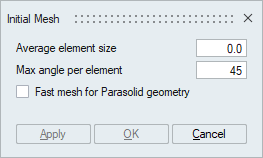Initial Mesh
![]()

Initial Mesh option is used to mesh the given body without affecting any features. Basically we would assemble (Node Matching) the bodies first before going for NVH mesh (which will be coarse). If we mesh the CAD model with necessary mesh controls with coarse mesh in the initial stage itself, then assembly would be affected because of coarse elements.
Average element sizeThe Element size basically denotes the average length of the sides of Tri element.
Max angle per elementThe approximation of a geometry is related to the angle made by an element edge on a perfect circle. Suppose the angle is 45 deg, then this will approximate a circle by 8 elements. This same measure is extended to an arbitrary curved surface.
Fast mesh for parasolid geometryFor Parasolid models, tessellation based initial meshing is supported to reduce the meshing time. Here the mesh size for each body is calculated internally. If the body has body mesh control, then the corresponding size will be used.
- Mesher uses single core as default, to perform the meshing. When an assembly has multiple bodies, single core meshing will mesh one body at a time. So the total time taken is the sum of the time to mesh each body. If the hardware supports multiple cores, user can request the mesher to use the multiple cores when meshing. When multiple solids are selected to mesh, the mesher will distribute the bodies between the cores and mesh them simultaneously. This will reduce the meshing time for assemblies with large number of bodies. Note that the amount of physical memory in the machine will also determine the performance of meshing. User can specify the number of cores in File | Preferences | Applications | Options. Currently multi core meshing is supported for Parasolid, STEP, CATIA (imported only through File | Import | CATIA - Direct) and SOLIDWORKS.
- One Mesh Model: For each CAD model we will have only one associated meshed model. When bodies from a CAD model are meshed for the first time, a new meshed model will be created and all the meshed bodies will be added. All subsequent meshing of the bodies from the same CAD model will be updated in the already created meshed model. Subsequent meshing of the same body will replace the old meshed body with the newly meshed body in the meshed model. This feature is enabled by setting the environmental variable SL_ONE_MESH_MODEL=TRUE.